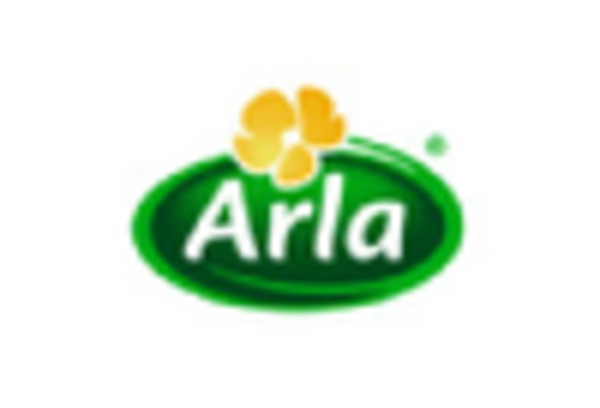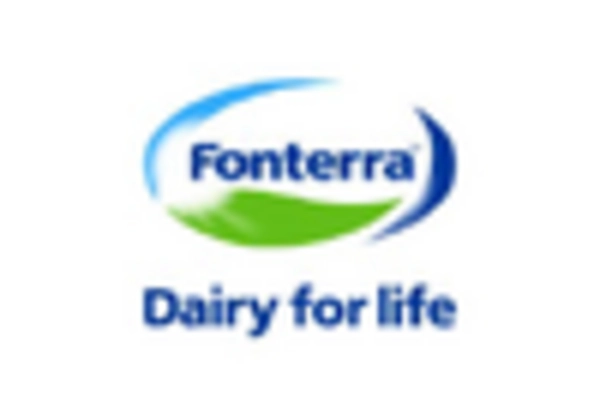Health-Conscious Choices
The Cheese Market is experiencing a notable shift towards health-conscious choices among consumers. As individuals become increasingly aware of dietary impacts, there is a growing demand for low-fat, reduced-sodium, and organic cheese options. This trend is supported by data indicating that the market for organic cheese has expanded significantly, with sales projected to reach substantial figures in the coming years. Consumers are actively seeking products that align with their health goals, which has prompted manufacturers to innovate and diversify their offerings. The Cheese Market is thus adapting to these preferences, leading to the introduction of functional cheeses enriched with probiotics and other health benefits. This evolution not only caters to the existing consumer base but also attracts new customers who prioritize health in their dietary choices.
Global Flavor Exploration
The Cheese Market is currently influenced by a trend of global flavor exploration. Consumers are increasingly adventurous in their culinary choices, seeking out cheeses that reflect diverse cultural influences. This trend is evident in the rising popularity of international cheese varieties, such as French Brie, Italian Parmigiano-Reggiano, and Spanish Manchego. Market analysis indicates that the demand for imported cheeses has grown, as consumers are eager to experience authentic flavors from different regions. This exploration of The Cheese Industry but also encourages cross-cultural culinary experiences. Retailers are responding by curating international cheese selections, thereby enhancing consumer access to a wider array of flavors. This trend suggests a potential for continued growth in the market as consumers remain open to experimenting with new and exotic cheese varieties.
Gourmet and Artisanal Cheese
The Cheese Market is witnessing a surge in the popularity of gourmet and artisanal cheeses. This trend appears to be driven by a growing appreciation for unique flavors and high-quality ingredients among consumers. Artisanal cheese producers are increasingly recognized for their craftsmanship, often using traditional methods that enhance the flavor profiles of their products. Market data suggests that sales of gourmet cheeses have seen a significant increase, reflecting a shift in consumer preferences towards premium products. This segment of the Cheese Market is characterized by a diverse range of offerings, including specialty cheeses infused with herbs, spices, and even local ingredients. As consumers seek out distinctive culinary experiences, the demand for gourmet cheese continues to rise, prompting retailers to expand their selections and promote these unique products.
Sustainability and Ethical Sourcing
The Cheese Market is increasingly shaped by consumer demand for sustainability and ethical sourcing practices. As awareness of environmental issues grows, consumers are more inclined to support brands that prioritize sustainable production methods. This shift is reflected in the rising popularity of cheeses produced from grass-fed cows and those that adhere to organic farming practices. Market data indicates that products labeled as sustainable are experiencing higher sales, suggesting that consumers are willing to pay a premium for ethically sourced cheese. This trend is prompting manufacturers within the Cheese Market to adopt more transparent supply chains and environmentally friendly practices. As sustainability becomes a key purchasing factor, the industry is likely to see further innovations aimed at reducing environmental impact while meeting consumer expectations.
Technological Advancements in Production
The Cheese Market is benefiting from technological advancements in production processes. Innovations such as automation and improved fermentation techniques are enhancing efficiency and product quality. These advancements allow producers to scale operations while maintaining consistency in flavor and texture. Market data indicates that the adoption of technology in cheese production is leading to increased output and reduced costs, which can ultimately benefit consumers through more competitive pricing. Additionally, technology is facilitating the development of new cheese varieties and flavors, catering to evolving consumer preferences. As the Cheese Market continues to embrace these advancements, it is likely to experience growth driven by both improved production capabilities and the introduction of innovative products that meet diverse consumer demands.


















Leave a Comment